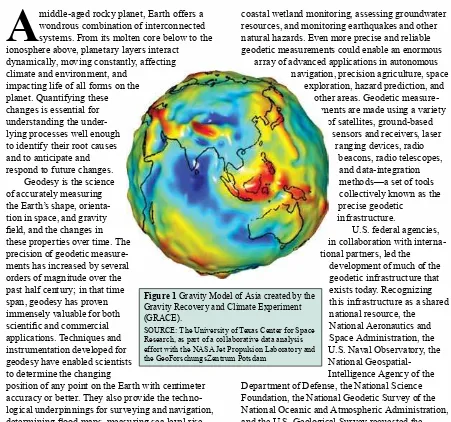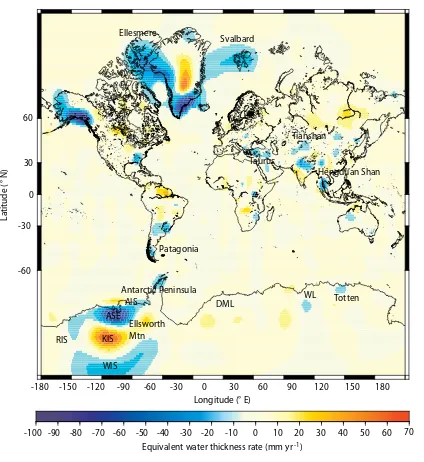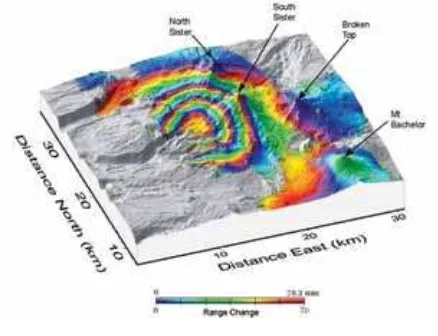Precise Geodetic Infrastructure
National Requirements for a Shared Resource
The geodetic infrastructure provides accurate information about fundamental properties of the Earth as they change over time and has led to many scientiic, civil, military, and
commercial applications. Numerous agencies and organizations have made valuable contri-butions to the geodetic infrastructure over the past half century; however, this critical infrastructure is now degrading from age and lack of support. Renewed investment in the geodetic infrastructure is needed to maintain and modernize existing systems and to enable the development of sophisticated new applications with signiicant economic, national security, and scientiic beneits.
A
middle-aged rocky planet, Earth offers a wondrous combination of interconnected systems. From its molten core below to the ionosphere above, planetary layers interactdynamically, moving constantly, affecting climate and environment, and
impacting life of all forms on the planet. Quantifying these changes is essential for understanding the under-lying processes well enough to identify their root causes and to anticipate and respond to future changes.
Geodesy is the science of accurately measuring the Earth’s shape, orienta-tion in space, and gravity ield, and the changes in these properties over time. The precision of geodetic measure-ments has increased by several orders of magnitude over the past half century; in that time span, geodesy has proven immensely valuable for both scientiic and commercial applications. Techniques and instrumentation developed for geodesy have enabled scientists to determine the changing
position of any point on the Earth with centimeter accuracy or better. They also provide the techno-logical underpinnings for surveying and navigation, determining lood maps, measuring sea level rise,
coastal wetland monitoring, assessing groundwater resources, and monitoring earthquakes and other natural hazards. Even more precise and reliable geodetic measurements could enable an enormous
array of advanced applications in autonomous navigation, precision agriculture, space
exploration, hazard prediction, and other areas. Geodetic
measure-ments are made using a variety of satellites, ground-based
sensors and receivers, laser ranging devices, radio
beacons, radio telescopes, and data-integration methods—a set of tools collectively known as the precise geodetic
infrastructure.
U.S. federal agencies, in collaboration with interna-tional partners, led the
development of much of the geodetic infrastructure that exists today. Recognizing this infrastructure as a shared national resource, the National Aeronautics and Space Administration, the U.S. Naval Observatory, the National Geospatial-Intelligence Agency of the Department of Defense, the National Science Foundation, the National Geodetic Survey of the National Oceanic and Atmospheric Administration, and the U.S. Geological Survey requested the Figure 1 Gravity Model of Asia created by the
Gravity Recovery and Climate Experiment (GRACE).
National Research Council to establish a committee to assess the state of the U.S. geodetic infrastructure, to deine the need for and role played by this infrastructure, and to make recommendations on how to maintain its viability in the future. In response to this charge, the committee reviewed prior studies and the scientiic literature and interviewed members of stakeholder communities to assess the scientiic and societal beneits of precise geodesy, explore opportunities for innovation, and suggest ways to improve national coordination to support the geodetic infrastructure.
The Need for Precise Geodesy
The ground beneath your feet may seem solid, but it is not. Rather than being a solid ball spinning like a perfectly-balanced top, the Earth is constantly moving and changing. Even in the middle of continents, the
ground moves up and down in response to lunar and solar tides; tectonic plates beneath the Earth’s surface shift and collide; earthquakes and volcanoes change familiar landscapes; and storms redeine shorelines. In addition, the Earth wobbles on its axis, causing its spin rate (and, as a result, the length of day) to change over time scales as short as hours. Some of the movements of the Earth’s surface and the planet as a whole are subtle and occur over long periods of time; others are sudden and catastrophic. All of these shifts can have signiicant impacts on human life.
The Earth’s constant movements also mean that determining the location or height of a speciic point on the Earth—for example, to predict where water may low in a lood—is not as simple as it may seem. Precision geodesy, which uses techniques both on the ground and in space, offers the opportunity to accurately measure and understand the changes on the Earth’s surface over time. Accurate measurements of the Earth are essential to improving our understanding of—and enhancing our ability to respond to or even predict—the processes behind many natural disasters, as well as climate change, sea level rise, and landscape changes at the local scale. High-precision measurements also enhance the many commercial, civil, and military applications of geodesy.
Applications of Geodesy
The science of geodesy has signiicantly improved our understanding of the Earth system and has led to a
Figure 2 Average global transport of mass in the Earth’s system, including estimates of the atmospheric mass in thickness of water equivalent.
SOURCE: Wu et al., 2010. Simultaneous estimation of global present-day water transport and glacial isostatic adjustment. Nature Geoscience Online (August 15), DOI: 10.1038/NGEO938. Why Precision Matters: Sea Level Rise
The rising global sea level provides a compelling example of the importance of precision measurements for science and decision making. Over the past decade, global sea level has increased by an average of 3.3 millimeters per year; some models predict that it will rise by as much as one meter by the end of the 21st century. Given the potentially devastating effects sea-level rise could have in low-lying inhabited areas, monitoring sea level rise is a high priority for many scientists and leaders. Because local sea levels luctuate as a result of tides and other forces, scientists depend on geodetic measurements that span the entire planet to track changes in global and regional sea level. However, scientists must always consider the level of possible error, or uncertainty, in their measurements. That uncertainty is currently comparable to the annual contribution of Greenland’s melting ice sheet to global sea level rise; this makes it more dificult to accurately predict sea level 100 years from now. Increased precision of the geodetic infrastructure is critical to accurately assessing and planning for the potential impact of sea level rise and other global changes on the ecology and human activities.[See igure below from Church and White, 2006. A 20th century acceleration in global
sea-level rise. GeophysicalResearch Letters 33(1).]
-180 -150 -120 -90 -60 -30 0 30 60 90 120 150 180
0 10 20 30 40 50 60 70 -100 -90 -80 -70 -60 -50 -40 -30 -20 -10
-60 -30 0 30 60
Ellesmere
Svalbard
Tianshan Taurus
Hengduan Shan
Patagonia
Antarctic Peninsula AIS ASE KIS RIS
Ellsworth Mtn
WIS
DML WL Totten
Equivalent water thickness rate (mm yr-1)
Latitude (
°
N)
Longitude (° E)
ubiquitous in our society today. Continuing to maintain the reference frames and improving the accuracy of positioning systems would enable even more precise navigation—for example, to support autonomous naviga-tion for vehicles, planes, and ships.
Precision agriculture. Geodetic instruments provide
high-accuracy positioning information farmers can use to plant crops in innovative patterns—such as interlacing two compatible crops on the same ield—for higher eficiency and environmental beneit. In addition, the geodetic infrastructure improves the accuracy of satellite and ground-based environmental sensors that monitor soil moisture and enhance weather predictions. The combination of precise positioning and accurate environ-mental monitoring has made possible comprehensive new farming systems that reduce waste and environ-mental impact.
Early warning for hazards. Geodesy enhances our
understanding of the mechanisms behind earthquakes, tsunamis, landslides, and volcanic eruptions, because all of these phenomena are related to changes in the shape of the Earth’s crust. Using geodetic techniques, scientists can measure subtle changes in the surface of the Earth that are associated with these phenomena, such as a slight uplift in the ground around a volcano before it erupts. High-precision, real-time geodetic observation systems placed in areas at risk of these natural disasters could help provide early warning for—and perhaps even someday help predict—such hazards. Such warning systems, however, are in the early stages of development and require greater geodetic capability than is available today.
Critical Geodetic Infrastructure
The geodetic infrastructure comprises a vast collection of ground and space-based equipment and data processing tools. This infrastructure is organized into networks focused on particular scientiic needs; the following are the critical geodetic networks that operate at the global scale, and support the International Terrestrial Reference Frame.
VLBI (Very Long Baseline Interferometry) uses radio telescopes to determine the position of the Earth in space.
GNSS (Global Navigational Satellite Systems, a generic term for systems like the U.S. Global Positioning System, GPS) use ground-based receivers and satellites to determine the locations of points on the Earth’s surface.
SLR/LLR (Satellite Laser Ranging and Lunar Laser Ranging) relects laser signals off satellites or the moon to provide information about the Earth’s surface and gravity ield, and the moon’s orbit.
DORIS (Doppler Orbitography and
Radiopositioning Integrated by Satellite) uses satellites and ground beacons to track the precise positions of satellites and measure the height of water in the Earth’s oceans.
Figure 3 An area of uplift near the Three Sisters cluster of volcanoes in central Oregon, mapped using satellite interferometric synthetic aperture radar (InSAR). Each concentric circle of red corresponds to approximately 28 millimeters in deformation.
SOURCE: Courtesy of the American Geophysical Union. Wicks et al., 2002. Magmatic activity beneath the quiescent Three Sisters volcanic center, central Oregon Cascade Range, USA.Geophysical Research Letters 29(7):1122.
host of applications. The following is a sampling of the current beneits of geodesy and potential future applications.
Elevation maps. High-accuracy surveys using
geodetic instruments have increased our ability to map the height of land and water features. Accurate maps are important for navigation, loodplain mapping, and many other needs. For example, the depletion of an under-ground aquifer can cause the land above to sink, disrupting underground utility lines. Precise measure-ments of land height help to identify when sinking is occurring and can inform response and mitigation efforts.
Navigation systems. Geodesy is critical to
main-taining the accuracy of GPS and other navigation
Committee on National Requirements for Precise Geodetic Infrastrucure: J. Bernard Minster (Chair), Scripps Institution of
Oceanography; Zuheir Altamimi, Institut Géographique National; Geoffrey Blewitt, University of Nevada; William E. Carter,
University of Florida; Anny Cazenave, Centre National d’Études Spatiales; Herb Dragert, Natural Resources Canada; Thomas A.
Herring, Massachusetts Institute of Technology; Kristine M. Larson, University of Colorado; John C. Ries, University of Texas at
Austin; David T. Sandwell, Scripps Institution of Oceanography; John M. Wahr, University of Colorado; James L. Davis,
Lamont-Doherty Earth Observatory at Columbia University (Liaison from Committee on Seismology and Geodynamics); David A.
Feary (Study Director), Lea A. Shanley (Postdoctoral Fellow), Nicholas D. Rogers (Financial and Research Associate), Courtney R. Gibbs (Program Associate), Eric J. Edkin (Senior Program Assistant), National Research Council.
The National Academies appointed the above committee of experts to address the speciic task requested by the National Aeronautics and Space Administration, the National Science Foundation, the Department of Interior – U.S. Geological Survey, the Department of Defense – National Geospatial-Intelligence Agency, the Department of Defense – United States Naval Observatory, and the Department of Commerce – National Oceanic and Atmospheric Administration’s National Geodetic Survey. The members volunteered their time for this activity;
their report is peer-reviewed and the inal product signed off by both the committee members and the National Academies. This report brief was prepared by the National Research Council based on the committee’s report.
For more information, contact the Board on Earth Sciences and Resources at (202) 334-2744 or visit http://dels.nas.edu/besr.
Copies of Precise Geodetic Infrastructure: National Requirements for a Shared Resource are available from the National
Academies Press, 500 Fifth Street, NW, Washington, D.C. 20001; (800) 624-6242; http://www.nap.edu.
Permission granted to reproduce this brief in its entirety with no additions or alterations. Permission for images/igures must be obtained from their original source.
© 2010 The National Academy of Sciences
speciications that can work with other GNSS networks around the world and stream high volumes of data in real time.
Collaborate on the global stage. The United States
should continue to participate in the activities of the Global Geodetic Observing System (GGOS) by
providing long-term support for the operation of geodetic stations around the world and by supporting the partici-pation of U.S. investigators in the activities of these services.
Maintain the International Terrestrial Reference
Frame. A long-term U.S. commitment to maintain the
International Terrestrial Reference Frame would provide a foundation for Earth system science, studies of global change, and a variety of societal and commercial applications.
Investigate workforce and education challenges. An
assessment of the geodesy workforce and the research and education programs in place at U.S. universities is needed to evaluate the long-term prospects of geodesy and its applications.
Establish a federal geodetic service. A federal
geodetic service charged with coordinatingthe modern-ization and operation of the geodetic infrastructure would ensure convenient, rapid, and reliable access to accurate geodetic data and products by government, academic, commercial, and public users. This service would not need to replace the geodetic activities currently carried out in a number of federal agencies; rather, it would build from the expertise and resources across these agencies to unify and bolster the national geodetic infrastructure and ensure that this shared resource meets the nation’s evolving economic, scientiic, and national security needs.
Optimizing Investments in the Geodetic
Infrastructure
U.S. federal agencies have made considerable contributions to the geodetic infrastructure on the global scale. These past investments, however, are degrading as the infrastructure ages. Unless the infrastructure is maintained, the existing applications that depend on accurate information about the Earth will degrade in quality, and progress toward more sophisticated applica-tions will stall. To capitalize on past investments and optimize future ones, the report recommends the following actions.
Make the most of existing instruments. In the near
term, the United States should construct and deploy next-generation automated SLR tracking systems at its four current SLR tracking sites (which are in Hawaii, Texas, Maryland, and California). It also should install next-generation VLBI systems at its four VLBI sites (which are in Hawaii, Texas, Maryland, and Alaska). Maintaining and upgrading these existing sites will leverage past investments and enhance the continuity of global reference frames as new geodetic technologies are deployed.
Augment the current infrastructure. In the long term,
the United States should deploy additional stations to complement and increase the density of the international geodetic network, in a cooperative effort with its interna-tional partners, with a goal of reaching a global geodetic network of at least 24 multi-technique (“fundamental”) stations.
Maintain a high-precision GPS network. The United


